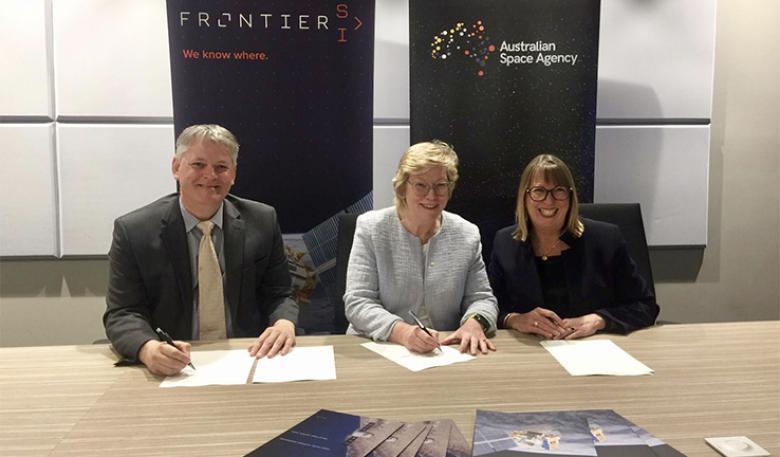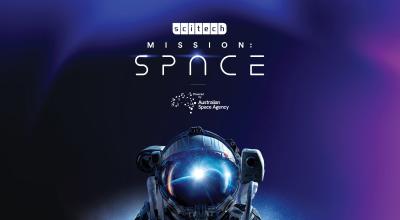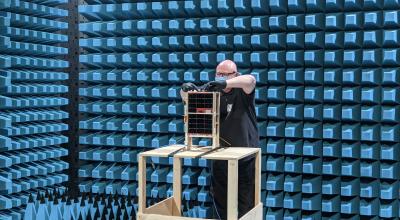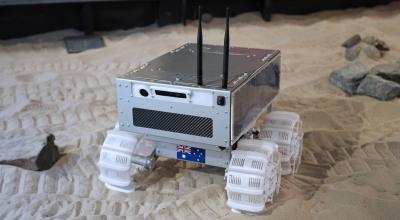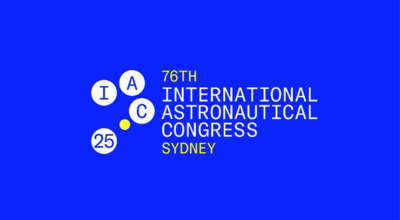The Australian Space Agency and Frontier SI signed a Statement of Strategic Intent and Cooperation which confirms the Agency’s commitment to work with industry that has strategic objectives that align with Australia’s Civil Space Strategy.
L-R: FrontierSI Chief Executive Officer, Dr Graeme Kernich; Head of the Australian Space Agency, Dr Megan Clark AC; FrontierSI Chair, Dr Gillian Sparkes
Read the full statement
The Commonwealth of Australia as represented by the Australian Space Agency, part of the Department of Industry, Innovation and Science, hereafter referred to as the “the Agency”, and represented by Dr Megan Clark AC, Head, Australian Space Agency; and Spatial Information Systems Research Ltd, trading as FrontierSI, hereinafter referred to as "FrontierSI" and represented by Dr Graeme Kernich, Chief Executive Officer, FrontierSI; and Dr Gillian Sparkes, Chair, FrontierSI;
Recalling that the Australian Civil Space Strategy 2019-2028 is a framework for the development and growth of the Australian space industry over ten years, underpinned by four strategic pillars: International; National; Responsible; and Inspire. Under these pillars the strategy endeavours to help realise opportunities and address challenges by opening doors internationally; increasing national space capability; promoting responsible regulation, risk and space culture; and building the future workforce. The Strategy sets a path for the Agency to triple the size of Australia’s space sector to $12 billion and create another 20,000 jobs by 2030;
Recalling that the Agency's purpose is to transform and grow a globally respected Australian space industry that lifts the broader economy, inspires and improves the lives of Australians – underpinned by strong international and national engagement;
Recalling that the Agency has seven National Civil Space Priority Areas including communications technologies and services; position, navigation and timing infrastructure; space situational awareness and debris monitoring; leapfrog research and development; Earth observation services; robotics and automation on Earth and in space; and access to space;
Recalling that the Agency’s responsibilities include: whole-of-government coordination of Australia's civil space sector matters, providing primary civil space policy and strategic advice to the Australian Government, supporting the growth of our national space industry and the use of space across the broader economy, leading international civil space engagement, administering space activities legislation and completing our international obligations, and inspiring both the Australian community and the next generation of space entrepreneurs;
Recalling that that FrontierSI is an Australian SME, leader in the development of collaborative cutting-edge, user-led space downstream and spatial innovations and growth-strategy implementation in Australia, New Zealand and globally. FrontierSI acts as prime, impartial entity, leading the investments and representing the interests of its (currently) 37 partners: 50% Australian private companies, 21% international, 13% universities and 16% Australian government;
Recalling that one of FrontierSI’s strategic objectives is to generate space derived information services in the space downstream applications market, particularly from positioning and earth observation; develop innovations and solve complex problems using applied geodesy, spatial infrastructures, analytics, artificial intelligence, image processing and to provide solutions to Australian customers in agriculture, health, mining, built infrastructure, intelligent transport, energy, government, defence and environmental sectors; and to support its partners in leveraging those innovations in the emerging (upstream) space sector in Australia and globally;
Acknowledging that the Agency and FrontierSI share the objective of growing a globally responsible and respected space sector in Australia, promoting investment and development in national space capability – particularly in areas of competitive advantage, helping open the door internationally for our research and industry sectors, supporting the creation of jobs, and enabling industry growth through the adoption of space derived services that will improve the day-to-day lives of all Australians;
Through this Statement, FrontierSI acknowledges the following current projects, areas of strategic interest and growth, potential new areas of collaboration, and support for education and training which are of interest to the nation.
1. Next generation Positioning, Navigation and Timing (PNT) infrastructure
Investment in the creation of the next generation of robust, reliable, ubiquitous positioning systems with a focus on system and sensor integration; development of error models and error mitigation systems; quality assurance and signal integrity; technology testing and evaluation; and the demonstration, implementation and benefits measurement of these technologies in cross-sector applications. Deploy world-leading expertise in multi-system, multi-sensor positioning infrastructure in Australia, expanding the work on projects such as the SBAS (Satellite Based Augmentation System) testbed, National Positioning Infrastructure (NPI) and leveraging international collaborations, such as the QZSS satellite augmentation signal demonstration with JAXA (Japan).
2. Earth Observation (EO) services
Provide leadership to, and management of, the SmartSat CRC EO Analytics research program – one of the three CRC’s research programs – in conjunction with the University of Queensland. This will include the development of end-user driven mission requirements for EO to ensure end users’ needs are incorporated from the outset; development of new algorithms, analytics, mathematical models and methods to solve industry problems; next generation EO sensor design optimisation to fill gaps in high temporal and spatial resolution; and deployment of new on-board processing and analytics in Australian-led EO missions.
Invest in the development of real-time representations of data and model cross-applications through the utilisation of Digital Twin technologies for ground and space applications to develop and provide services that integrate positioning and remote sensing technologies to support real-time asset management and Internet of Things (IoT) systems and data integration.
3. Increase capability through national industry development
Increase the demand and number of providers of space related services through industry growth strategy development activities that cover end-to-end space and spatial infrastructure development, including: continuation of the 2026 Spatial Industry Transformation and Growth Agenda (2026Agenda) implementation; defining and running the EO-focused technology incubation program Digital Earth Australia Initiative (DEA) Labs program, initiating and running the Australian Geospatial Intelligence Organisation (AGO) Analytics Lab incubation program (Department of Defence), and leveraging existing relationships with international industry building organisations (such as the European Space Agency (ESA)).
4. Leapfrog research and development (R&D)
Continue our strong history of driving economic growth and better government services through leading and growing space-based R&D capability in positioning, applied geodesy, spatial infrastructures and analytics, including cutting edge R&D on EO data analytics and investment in the SmartSat CRC. Lead the pack by leveraging university and private sector partners and driving the adoption of these capabilities through FrontierSI’s application networks.
5. Inspire and build the future workforce
Invest in training, PhD and Masters Scholarships, higher degree research supervision and contributing to STEM education in space downstream applications through our university partners and through hands-on experience through our industry partners; increasing diversity by making space accessible to students and professionals in areas not traditionally aligned with the space industry, including city planning, health and agricultural sciences. This includes, building higher degree research capability in real-time spatial property valuation data and tools through our Value Australia initiative; creating open and freely accessible access to training materials for the Copernicus Australasian Data Hub; and growing the global open source community for the Open Data Cube.
This Statement constitutes the expression of both parties' intention to continue discussions. This statement does not create legal obligations between the parties and does not establish the obligation to enter into a certain agreement.

